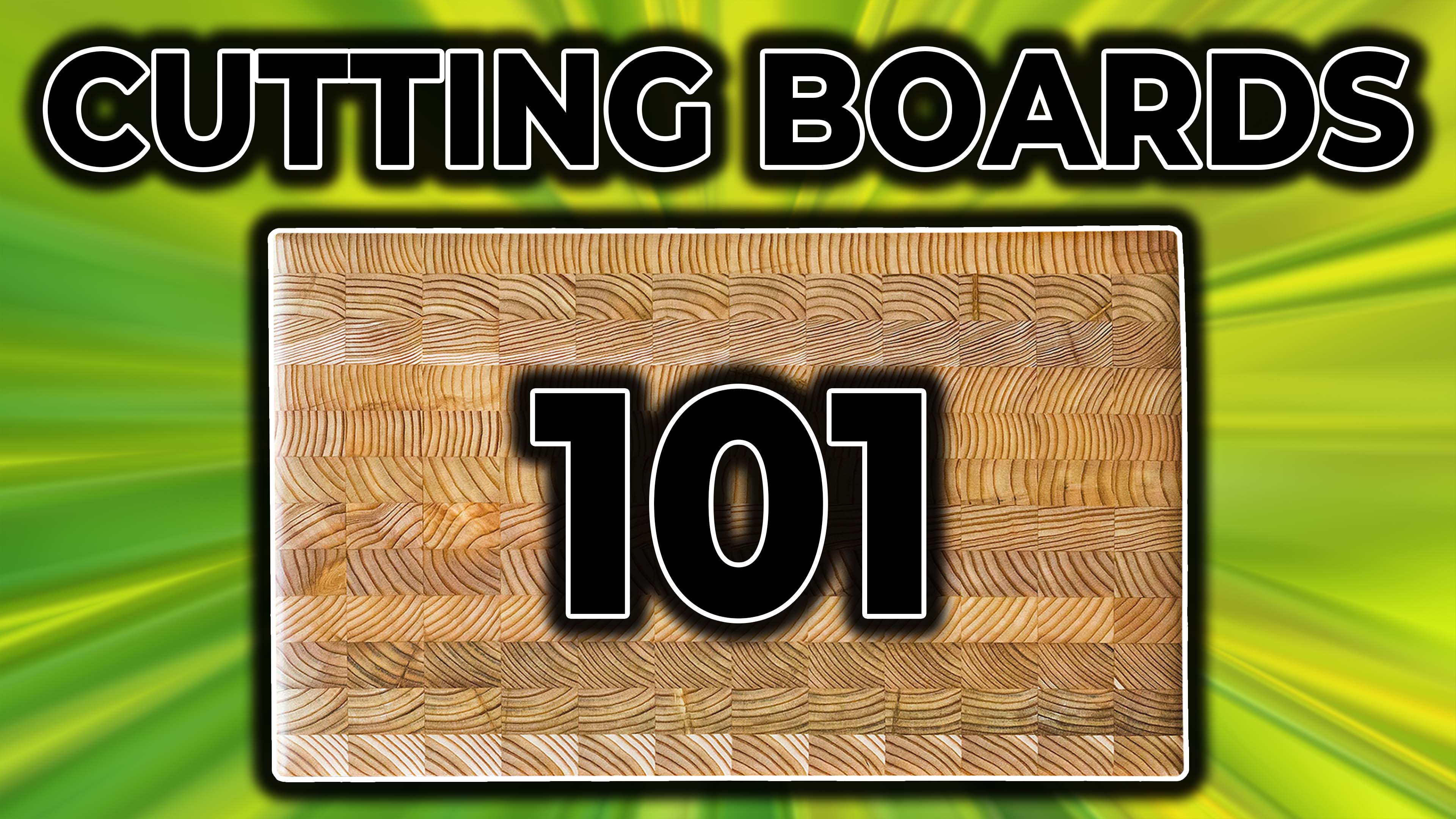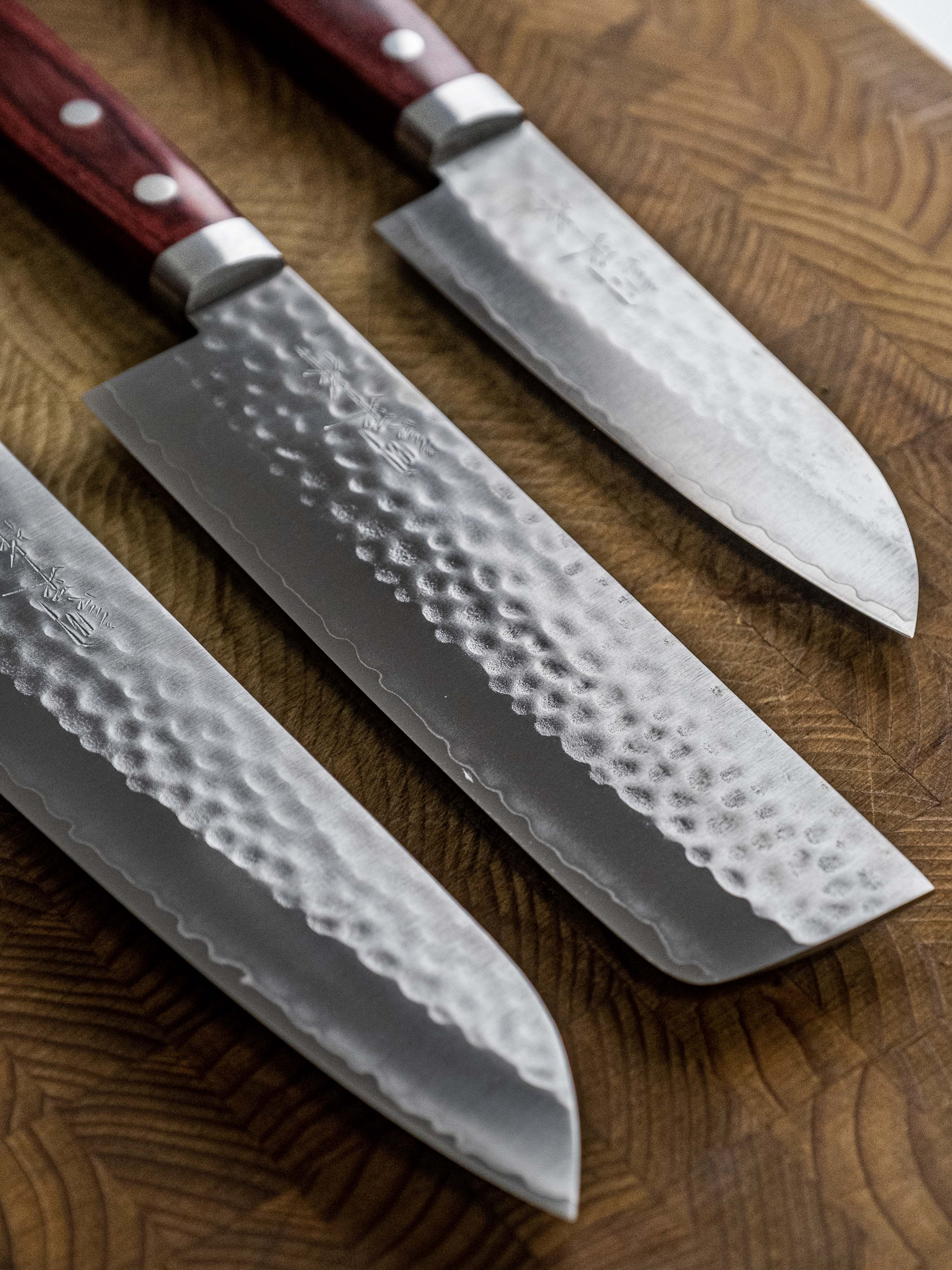Menu

Cutting Boards 101
Hey guys! Jake from Sharp and today we're going to talk everything cutting boards. We'll go over the different materials, and how to take care of them. Lets get right into it!
So next let's chat about how we're going to care for these guys. While the plastic and rubber boards are going to require much care please read through as I'll specify which tips apply to which types of boards.
Moisturising -
This is going to be the most important part of keeping your cutting board healthy and will only apply to wooden cutting boards. When your cutting board is brand new or has been used for a while and the wood starts to lighten its time to moisturise the board. At the shop we sell cutting board conditioner which is a great no mess option and can be loaded onto a lintless (microfibre clothes work great) rag and wiped over the dry areas of the board. That being said you can also use food safe mineral oil. When using the oil apply a generous amount and wipe it over the board. Leave it for 20 minutes and then wipe off the excess. I personally like to do this before bed so that by the time I wake up the excess oil has soaked into the board and you don't have to worry about it getting into your food.
This is important for a few reasons. First, it will help prevent warping and splitting of your cutting boards. And second if the cutting board is well hydrated it will be less likely to absorb bacteria, odours, and colours from the foods you're preparing. Nothing worse than a hint of last nights onion and garlic in your freshly sliced fruit in the morning.

Storage -
This will apply to all cutting boards but glass (but seriously if you've read this far and still want to use a glass cutting board you've got bigger issues). I personally leave my cutting board out on the counter all the time, its there when I need it and I don't need to worry about moving a big heavy board in and out of a cabinet every time I want to make something to eat. That being said if this is the case its important to keep it out of direct sunlight as it will cause the top to dry faster than the bottom which can lead to warping or splitting at the glued joints (On that note, if your cutting board doesn't have feet to keep it up off the counter make sure to flip it over every few days to prevent warping). Now if your kitchen is tight, or you prefer to put everything away after you cook and you store it in a cabinet thats great too, just make sure its standing upright and not leaning over to one side as over time this will warp the board as well.

Cleaning -
While some people argue that wooden boards aren't as sanitary as plastic boards, unless you have a commercial grade dishwasher that runs close to 200 degrees and finishes with a bleach rinse cycle you're better off cleaning it by hand, evening the playing field. Personally my cutting board is too big for a dishwasher...and my apartment doesn't have a dishwasher, so I do mine by hand. It doesn't fit on the sink so it gets cleaned right on the counter and I've never had any issues with the sanitation of my board. Heres how I clean mine! First I wipe off any excess food waste with a paper towel, and then scrub it down with a soapy sponge. Using the side with the scouring pad helps to very lightly sand the board while you clean it every time keeping your work surface smooth and minimising any scratches. Again my board is too large for the sink so I wipe off all the soap with a damp rag, rinse it out and repeat until I feel like I've got it all. The last step is to sanitise it. I have a spray bottle with a splash of bleach and I lightly spray it down and let it air dry until its next use. Bleach evaporates quickly so you don't have to worry about any off flavours or harmful effects.

Technique -
We've talked about the boards, now let's talk about you. None of the boards on this list are going to be invincible and deep scratches or gouges can be a place for bacteria to hide and grow so we'll need to minimise the damage we're causing to our boards. It's important to not be too forceful when cutting and that is amplified when using the tip or the heel of the knife as all that pressure is on one small portion of the blade, making it easy to dig in and leave a deep mark. Also, I'd take it easy with the cleaver trying to chop through bones on these guys and have an old beater cutting board for that as that will always damage your board.

-
PLASTIC
Plastic boards are likely the most common as they're affordable and durable. That being said they're not the best(or worst to be fair) for your knives.
PROS
-Affordable
-Drop proof
-Can be put in a dishwasher
CONS
-High temps of dishwasher can cause warping
-Can vary in hardness causing knives to chip
-Can't be planed
- WOOD
Wooden boards come in two varieties, cross grain and end grain. One of the best materials for your knives and will last a lifetime if cared for.
End grain boards are made up of lots of small pieces of wood pointing upwards towards the work surface. These are great because they're less prone to warping and the edge of your knife will go between the wood fibres instead of across, or worse, through the fibres of a cross grain board.
Cross grain boards are softer than plastic and more affordable than end grain boards. A great option on a budget.
PROS
-Durable
-Good for edge retention
-Heavy, so they'll stay firmly in place when in use
CONS
-Can't be put through the dishwasher
-More expensive than plastic
- GLASS/BAMBOO
I know what you're thinking, but Jake, bamboo is wood! And you're right. But unfortunately it doesn't share the same qualities as other woods used for cutting boards and is too hard which is why I've put it into the same category as glass.
PROS
-Cheap
CONS
-Too hard and will damage knife
-Glass is dangerous to have around food while cooking
-Don't buy these
-Seriously, don't
-I mean it
- RUBBER
These are some interesting boards that can be challenging to find in North America but are very popular in high end restaurants.There are two types. The first has layers and as the board develops a rut in the centre you peel a layer off and have a brand new work surface. The second type is a thin steel plate for rigidity covered in a medium density thick layer of rubber.
PROS
-Very soft, so great for your knives
-Can be put in the dishwasher
-Very quiet
-Drop proof
CONS
-Very expensive
-Difficult to find
So next let's chat about how we're going to care for these guys. While the plastic and rubber boards are going to require much care please read through as I'll specify which tips apply to which types of boards.
Moisturising -
This is going to be the most important part of keeping your cutting board healthy and will only apply to wooden cutting boards. When your cutting board is brand new or has been used for a while and the wood starts to lighten its time to moisturise the board. At the shop we sell cutting board conditioner which is a great no mess option and can be loaded onto a lintless (microfibre clothes work great) rag and wiped over the dry areas of the board. That being said you can also use food safe mineral oil. When using the oil apply a generous amount and wipe it over the board. Leave it for 20 minutes and then wipe off the excess. I personally like to do this before bed so that by the time I wake up the excess oil has soaked into the board and you don't have to worry about it getting into your food.
This is important for a few reasons. First, it will help prevent warping and splitting of your cutting boards. And second if the cutting board is well hydrated it will be less likely to absorb bacteria, odours, and colours from the foods you're preparing. Nothing worse than a hint of last nights onion and garlic in your freshly sliced fruit in the morning.

Storage -
This will apply to all cutting boards but glass (but seriously if you've read this far and still want to use a glass cutting board you've got bigger issues). I personally leave my cutting board out on the counter all the time, its there when I need it and I don't need to worry about moving a big heavy board in and out of a cabinet every time I want to make something to eat. That being said if this is the case its important to keep it out of direct sunlight as it will cause the top to dry faster than the bottom which can lead to warping or splitting at the glued joints (On that note, if your cutting board doesn't have feet to keep it up off the counter make sure to flip it over every few days to prevent warping). Now if your kitchen is tight, or you prefer to put everything away after you cook and you store it in a cabinet thats great too, just make sure its standing upright and not leaning over to one side as over time this will warp the board as well.

Cleaning -
While some people argue that wooden boards aren't as sanitary as plastic boards, unless you have a commercial grade dishwasher that runs close to 200 degrees and finishes with a bleach rinse cycle you're better off cleaning it by hand, evening the playing field. Personally my cutting board is too big for a dishwasher...and my apartment doesn't have a dishwasher, so I do mine by hand. It doesn't fit on the sink so it gets cleaned right on the counter and I've never had any issues with the sanitation of my board. Heres how I clean mine! First I wipe off any excess food waste with a paper towel, and then scrub it down with a soapy sponge. Using the side with the scouring pad helps to very lightly sand the board while you clean it every time keeping your work surface smooth and minimising any scratches. Again my board is too large for the sink so I wipe off all the soap with a damp rag, rinse it out and repeat until I feel like I've got it all. The last step is to sanitise it. I have a spray bottle with a splash of bleach and I lightly spray it down and let it air dry until its next use. Bleach evaporates quickly so you don't have to worry about any off flavours or harmful effects.

Technique -
We've talked about the boards, now let's talk about you. None of the boards on this list are going to be invincible and deep scratches or gouges can be a place for bacteria to hide and grow so we'll need to minimise the damage we're causing to our boards. It's important to not be too forceful when cutting and that is amplified when using the tip or the heel of the knife as all that pressure is on one small portion of the blade, making it easy to dig in and leave a deep mark. Also, I'd take it easy with the cleaver trying to chop through bones on these guys and have an old beater cutting board for that as that will always damage your board.

The Inevitable -
And last but not least, eventually all of these boards will develop a rut in them. Usually by the centre where most of the work is done. While this can take years before it's noticeable, it is ultimately unavoidable. With wooden boards I suggest seeing if theres a woodworking shop locally that you can get them to pass it through a planer for you. If thats not an option get a large sanding block and get to work with some low grit sandpaper until you've exposed a new work surface. Once its flat you can finish up on a higher grit (320-400) to get it nice and smooth and make sure the edges are splinter free. You'll probably notice that the newly exposed surface will be quite light in colour and thats because the conditioner and oil only penetrate so far in, creating a protective coating, but not all the way through the board. When moisturising be very generous this time and wipe off the excess after half and hour, do this 2-3 times until you've achieved a finish you're happy with. As for the plastic and rubber boards that don't peel, once you've got a rut you're pretty much out of luck. While there are services that will plane plastic cutting boards they are few and far between and can end up costing more to ship your board to and from than to just buy a new cutting board.
Well, that's it guys. If you follow these steps and buy yourself a good cutting board it will last you for years to come and leave your knives sharper, for longer.
Until next time, stay sharp!
- Choosing a selection results in a full page refresh.




